
This site celebrates the life and work of sculptor John
Cassidy (1860 - 1939).
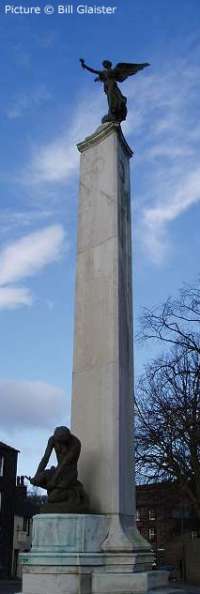
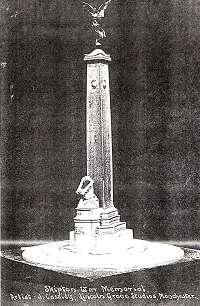
The design model for the memorial - picture courtesy of Skipton Library.
The overall architectural design was by the Manchester-based architect James Henry Sellers (1861-1954). Sellers designed a number of memorials in which a stone column is topped by a winged victory, such as those at Mere, Cheshire (since destroyed) and Failsworth, Lancashire.
His design for Skipton is possibly the largest of his memorials located so far, and the most complex in the development of its Neo-Classical geometric form, from its tri-lobe base to the three sided shaft with dished faces and fluted angles. It is also the only one of his column memorials located so far to incorporate an additional and significant sculpture, Cassidy's figure of a man breaking a sword.
(Thanks to Stuart Evans of Central Saint Martins College of Art and Design, London, for this information.)
Matthew Wilson
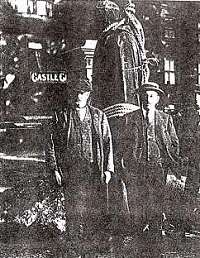
To free the site for the memorial, the statue already there, of Sir Matthew Wilson, Bart (1802-1891) of Eshton Hall, Skipton's first Member of Parliament, was relocated.
Sir Mathew had the unusual pleasure of being present at the unveiling of his own statue - such a commemoration is usually reserved until after the death of the subject.
This picture (courtesy of Skipton Library) shows the work in progress: the scene reminds us somehow of Rodin's famous work 'The Burghers of Calais.' To quote from the former SkiptonWeb site:
'Sir Mathew struck a dashing figure in national politics ... being elected twice to parliament, and on both times being thrown out for what appears to be vote-rigging! However, back he came, at the grand old age of 83, to be elected MP for the Skipton Division in 1885.
'Sir Mathew's statue was erected in 1888, at the top of the High Street where now stands the War Memorial, and at the time of its unveiling there was huge controversy as to whether the statue should ever have been contemplated at all. It seems Sir Mathew's friends wanted to mark his life-long service to the Liberal cause by having a statue of the prominent politician placed within the High Street. Very commendable, except that many in the town - while perhaps not adverse to the idea were certainly 'agin' paying for it. To get around this problem, the statue was paid for by his Bradfordian cronies and with no cost going to the local taxpayers the statue duly arrived.'
Today, the Wilson statue stands further down the High Street, surrounded by stalls on market days.
Inscriptions on the bronze plaque:
1914 - 1918
THESE WERE THE BRAVE UNKNOWING HOW TO YIELD
WHO, TERRIBLE IN VALOUR, KEPT THE FIELD
AGAINST THE FOE AND HIGHER THAN LIFE'S BREATH
PRIZING THEIR HONOUR, MET THE DOOM OF DEATH
AND NOW THEY REST PEACEFUL, ENFOLDED IN THEIR COUNTRY'S BREAST.
Skipton, North Yorkshire
War Memorial (1922)
Skipton, or Skipton-in-Craven to give its full name, is a very pleasant market town in North Yorkshire, noted for its castle. At the top of the High Street stands the town's Memorial to over 370 Skipton men who lost their lives in the 1914-18 war.
As in many towns, there was much discussion about how to commemorate the fallen. A Committee was formed, which proposed the creation of playing field. Land was purchased, only for the plan to be rejected, eesulting in the resignation of the Committee in 1919.
At a meeting on 22 March 1920 the selection of a War Memorial Monument was made by a re-formed War Memorial Committee. Cassidy was commissioned to execute and erect the Monument at a cost not exceeding £3,000. The monument was unveiled on 8 April 1922.
WAR MEMORIAL UNVEILED
(Yorkshire Post and Leeds Intelligencer, 10 April 1922, p.7)There were impressive scenes at the unveiling of the Skipton War Memorial on Saturday. The memorial is in the form of a monument 36 feet high. It is of Portland stone, and is surmounted a winged figure representing Victory, while at the base the column rests a second figure in stooping posture represented as breaking the sword across his knee.
The unveiling ceremony was performed in the presence of a large crowd by the children of the fallen soldiers belonging the town They recited words specially composed for the occasion. The cords attached to the shroud were pulled by the following four children, selected by ballot: Cyril Webster, William Smith, Ethel Bellas, and Ivy Mason.
A brief address was delivered by Mr. J. W. Broughton (Chairman War Memorial Committee), and the ceremony of dedication was perrformed by the Ven. Archdeacon Craven (the Rev. H. L. Cook). The Ministers of several nonconformist churches in the town also took part in the service. Following the service, over a hundred wreaths were placed at the foot of the memorial, including tributes from most of the public bodies in the town.
The memorial
The triangular limestone pillar, about 20 feet (six metres) high, carries a bronze figure of 'Winged Victory' and at the base is a nude man modelled in the act of breaking a sword.
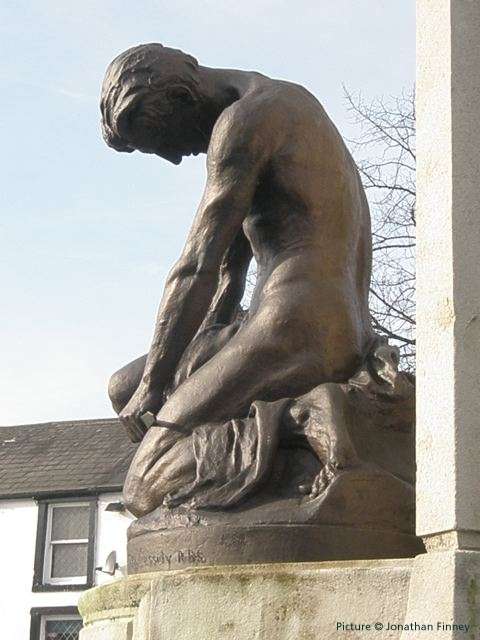 |
Above we display a selection of excellent pictures sent to us by Jonathan Finney. The image will change every eight seconds in you have Javascript enabled in your browser.
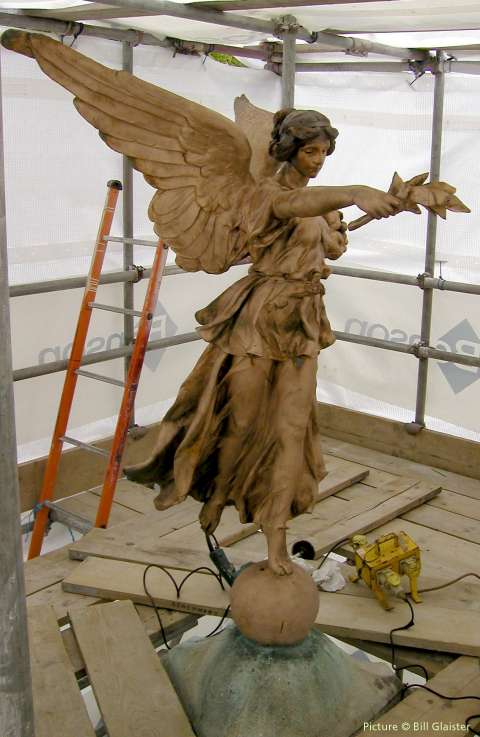
The memorial was given a thorough clean and refurbishment in 2005, and we were kindly contacted by Bill Glaister, from the firm involved in this work, who has supplied us with these fine pictures.
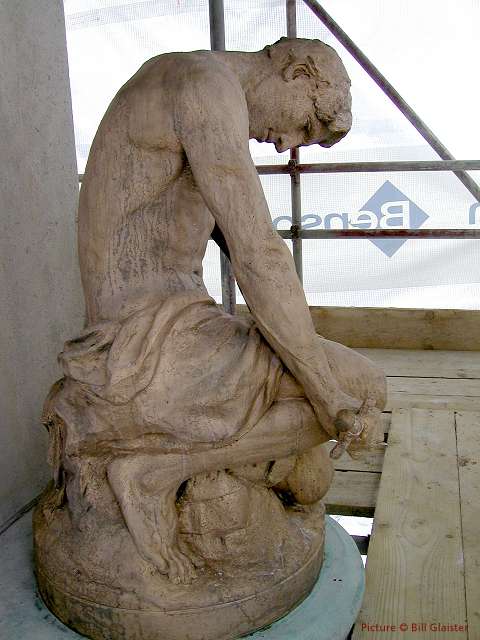
The sword-breaker.
Cassidy's meaning in this piece does not appear to have been explained in print, although it would certainly have been approved in model form by the Committee.
Our interpretation is that it signified the end 'The war to end all wars' (as was thought at the time; weapons would no longer be needed. ) The concept of 'The spirit of Peace breaking the sword of War' was current at the time, although such images were sometimes misinterpreted.
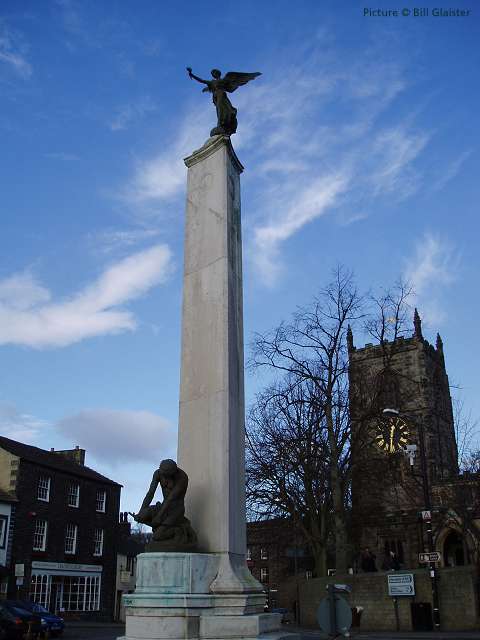
The memorial in its setting.
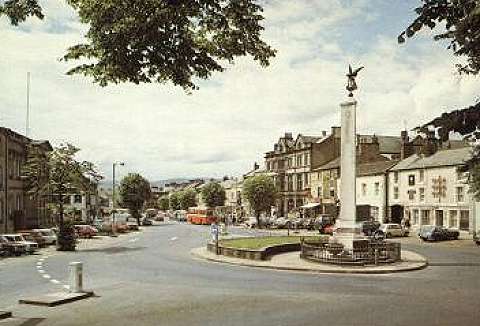
From a postcard, circa 1970.
Footnote: Freddie Trueman
The 21st century seems to be seeing a revival in the fashion for memorial portrait sculptures: as we originally wrote this page in 2008, an appeal was in progress to create a statue of famous Yorkshire cricketer Freddie Trueman (1931-2006) , to be erected in Skipton and modelled by Graham Ibbeson, one of the country’s most popular figurative sculptors, creator of the statue of Eric Morecambe now to be found in the town of Morecambe. Interestingly, the cost of the final bronze, to be eight feet high, was estimated at £80,000 - £100,000 - allowing for inflation of the currency, not so different from what Cassidy would have charged.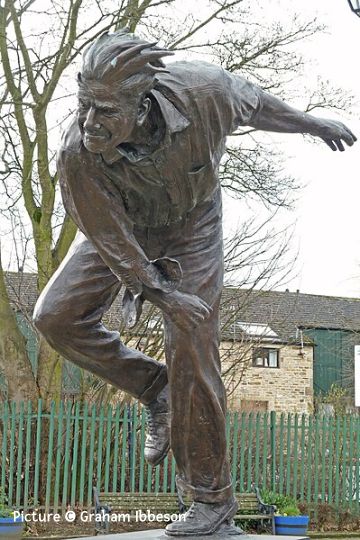
The appeal succeeded, with the help of corporate sponsors, and the work was unveiled on 9 March 2010.
Links and references
UK National Inventory of War Memorials - Skipton
There are 38 War Memorials listed in the town of Skipton - mostly withing buildings, as erected by various organisations to commemorate their members.
Skipton Town Council
Old pictures from the Rowley Collection
Skipton Library
Written by Charlie Hulme March 2008. Updated March 2021.